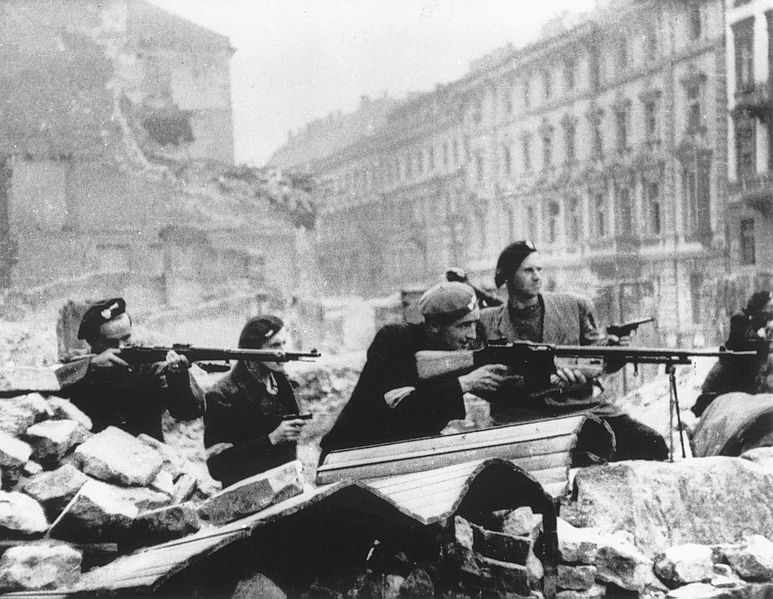On August 1, 1944, the underground army in Warsaw was comprised of 36,500 mobilised Home Army soldiers - including about 32,500 in Warsaw and about 4,000 in suburban areas.
The beginning of “Operation Bagration” on 22 June 1944 in the territory of Belarus resulted in the quick defeat of the German Army Group “Centre”. In the summer of 1944, the 1st Belorussian Front was located near Warsaw. Based on the military situation, the Commander of the Home Army (AK) made the preliminary decision to call for an uprising in Warsaw. The operation was to be aimed militarily at the Germans and politically at the Soviet Union.
Despite conflicting opinions among the ranks, the General Headquarters made the final decision on 31 July 1944 to begin fighting in the capital by setting the “W-hour” for 5.00 p.m. on 1 August 1944. This strategic decision was affected by the threat of Warsaw being turned into a fortress, temporary abandonment of the city by the occupying civil authorities, and the call for active combat against the German forces broadcast on the evening of 29 July 1944 by Radio Moscow in the Polish language. It was also reported that the Red Army troops had liberated some locations near Warsaw: Radość, Miłosna, Okuniew, Wołomin and Radzymin.
On August 1, 1944, the underground army in Warsaw was comprised of 36,500 mobilised Home Army soldiers - including about 32,500 in Warsaw and about 4,000 in suburban areas. The reason for such low numbers was hasty mobilisation. It should also be noted that the levels of training among the AK soldiers varied widely in quality. Troops experienced in fighting the Germans, like Kedyw and other branches of the AK District, had the highest combat value.
In the first days of the Uprising, the insurgent attacks designated as part of the offensive actions were clearly a failure. Important sites that fell into the hands of Polish forces were the Prudential building, the power plant in Powiśle, German warehouses in Stawki, the court building in Leszno, the Town Hall at Theatre Square, the detention centre on Daniłowiczowska St., the Military Geographical Institute building on Jerusalem Avenue, the office of the Municipial Transport Company on Świętokrzyska St., Czechoslovak Legation on Koszykowa St., several school buildings converted into barracks as well as the railway building in Praga. Assaults on the airfield of Okęcie, railway stations and bridges were not successful. In the days following the Uprising, Wola and Ochota became the first districts to be lost, assaulted by the brigade of General Oskar Dirlewanger that was comprised of criminals and poachers and assisted by the police forces of SS-Gruppenführer Heinz Reinefarth. The SS units together with the Ukrainian RONA led by Kamiński massacred civilians in the Wola district. Ochota was also not spared.
From 12 August 1944, the insurgents held the following isolated districts: Stare Miasto, Śródmieście, Czerniaków, Mokotów and Powiśle. Despite some scattered successes such as capturing the PAST building, the Uprising was actually being finished off. The situation was also influenced by the fact that the Red Army stopped its offensive operations, the Allied planes with supplies for Warsaw could not land in the zone controlled by the Soviets, and the airdrops were inaccurate. The heroism of the insurgents could neither withstand the overwhelming enemy forces nor endure shortages of supplies, especially of weapons.
In the face of the tragedy that befell fighting units and civilians, the Commander of the Home Army began mediation with the Germans. As a result of the capitulation order signed on the night of 2 October 1944, the Uprising finally came to an end. Some troops were taken into captivity (in accordance with the decisions of the Home Army they were granted veterans rights), but many soldiers integrated with the civilian population and left the city. About 10,000 Home Army soldiers were killed, in addition to 6,000 who went missing and 20,000 injured. About 15,000 Home Army soldiers were captured by the Germans. The number of casualties among the civilian population remains unknown. It is estimated that 150,000 to 200,000 civilians died during the Uprising. According to the testimony of von dem Bach-Zelewski, the German losses in Warsaw were as follows: 10,000 killed, 7,000 missing and 9,000 wounded - 26,000 soldiers in total. However, those figures are disputed by many historians. As far as material losses are concerned, the authors of the “Report of War Losses in Warsaw”, prepared in 2004, estimated the entire material losses incurred by the city and its citizens during World War II at 18.2 billion pre-war zlotys (according to the value of zloty in August 1939), i.e. USD 45.3 billion (current value).
by Daria Czarnecka
LITERATURE
Władysław Bartoszewski, Dni walczącej stolicy [Days of the Fighting Capital] Kronika powstania warszawskiego [Chronicle of the Warsaw Uprising], Warsaw 2008.
Jan M. Ciechanowski, Powstanie Warszawskie [The Warsaw Uprising]. Zarys podłoża politycznego i dyplomatycznego [An Outline of the Political and Diplomatic Ground ], Pułtusk-Warszawa 2009.
Marek Getter, Straty ludzkie i materialne w Powstaniu Warszawskim [Casualties and Material Losses in the Warsaw Uprising], “Biuletyn IPN”. 8-9 (43-44), August – September 2004.
Raport o stratach wojennych Warszawy [Report of War Losses in Warsaw]. Warsaw, November 2004.
This article was prepared in cooperation with Historykon.pl.
